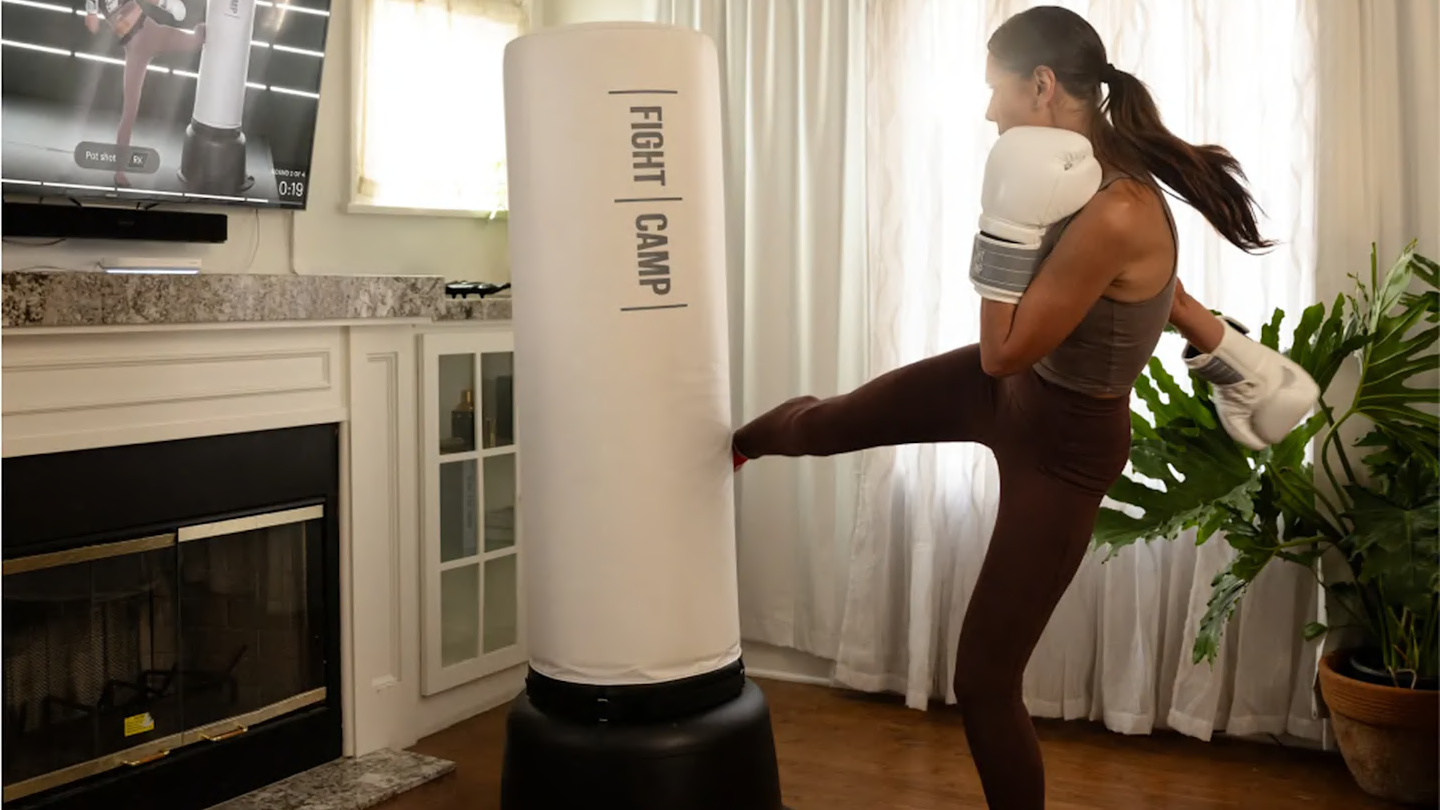Fitness
Never Stop Pushing: This Indoor Cycling Plan Can Help You Hit Peak Performance

Winter weather is almost here, and unless you’re heading into the last few cyclocross races of the season or planning a serious fat bike racing program, you’re probably ready for a break. But taking an off-season from cycling doesn’t have to mean losing fitness in the process. Enter: maintenance mode.
Luckily, stationary trainers make indoor cycling accessible and simple for those who live in winter climates.
If you’re not someone who looks forward to trainer season and sees the winter as a time to maintain fitness rather than add to it, we have all the advice you need to do so. For those who love racing on Zwift or using a WattBike workout to boost their FTP, winter is less about maintenance and more about making improvements, but platforms like these (and the tips we have here) can also help keep you riding steady.
No matter your winter goals, we have the best ways for you to make the most of your indoor training and maintain your fitness straight through winter. Consider this guide—including an indoor cycling plan that’s all about maintenance—your ticket to elevated rides come spring (no slogging through those first few sessions for you!).
Make Indoor Training Exciting
Riding your trainer doesn’t have to be a drag! The trainer makes maintenance simple: Have your trainer permanently set up in a well-ventilated room or garage and rather than taking 20 minutes to get ready to ride, you can be pedaling away in under two minutes. Plus, during the holiday season when kids are home from school or your schedule gets super hectic, the trainer makes it easy to get your workout done right at home.
“We’re so lucky with trainers now, because you can maintain fitness with such little time thanks to the efficiency that they provide,” says former pro Christian Vande Velde, who now works with the Breakaway App, which provides AI-based coaching for cyclists. “When you train indoors, you never stop pedaling. There are no stoplights, there’s no traffic. You can do uninterrupted perfect intervals every time and be solely focused on your own performance.”
Prioritize Consistency
If you have four hours to train per week, make it these workouts: three 45-minute rides, one hour-long ride and a strength training session. This will be much better for maintenance—and possibly even gains!—compared to a single four-hour ride. Moving in some capacity most days will serve you better than cramming your riding into one to two days, says Ryan Kohler of Fast Talk Labs.
Kohler prefers ride durations of at least 45 minutes whenever possible—though if 30 minutes is all you have time for, that’s much better than nothing! You can maintain your fitness in as little as three hours per week if you can spread that out over three to four rides, he says.
Ideally, you’d add an hour of strength on top of that. Plus, it’s smart to add in some other movement types when possible (like taking your pup on a few longer walks rather than the usual backyard pee stop).
Strength Train Regularly
Speaking of strength, Kohler is a huge fan of weight training in the offseason/maintenance season for both overall health and power-boosting reasons. “I try to push everyone to integrate some strength into their training during this time of year,” he says. “It’s motivating to just see what you can accomplish when you first start strength training, and it gives you new goals to work toward so you’re not focused solely on cycling metrics.”
You don’t need an aggressive strength training plan, though. Cyclists can make major strength gains with a few basic bodyweight exercises or dumbbell workouts.
Have a Purpose for Each Ride
For many people, you’re not here (and by here, we mean on Zwift Island) to make friends. You’re in this to get on the bike, get your ride done, and get back to your day—and that’s fine! But don’t just pop on the bike and pedal aimlessly for 30 minutes. Each time you get on the bike, you should have a plan for the ride.
You can work with a coach like Kohler or use a program from The Breakaway, Wattbike, or dozens of other training apps to guide your rides, but when you only have a few hours a week to devote to riding, it’s important to have some kind of structure to your days.
“It’s so important to have an intention going into every ride,” says Vande Velde. “Having a plan that you follow helps take away the cognitive load of trying to figure out ‘what should I do today?’ and helps you jump on the bike and just get to it.” (If you want an easy maintenance plan to follow, we’ve got that for you below, too!)
Hit All the Zones Most Weeks
Most of us have a favorite zone or two to ride in. Everyone loves a zone 1 recovery ride at a nice easy pace, and most riders have a certain type of higher-intensity zone where they thrive. Maybe you love doing hour after hour at tempo pace, or you prefer ultra-high-intensity, all-out sprints. Maybe you’re one of the few who just loves the grind of riding at threshold for long intervals.
It’s tempting to stick to just one type of workout while in maintenance mode, thinking you’re simplifying things. But Charlotte Backus, cycling coach and Wattbike ambassador, points out that if you stay in just one or two zones, those are the only zones you maintain.
“My biggest advice is to touch on each zone on a weekly basis,” she says. “It doesn’t have to be fancy: Have a day that’s all in zone 2 endurance, have a day where you’re doing some tempo, have a day of threshold work, and then have a day where you’re doing sprints. Just make sure you warm up and cool down before your intervals!”
Don’t Skimp on Recovery
Maintenance mode may seem like a great time to drop a couple of pounds, but Backus warns against skimping on recovery postride. Sure, you’re not out there doing a five-hour sufferfest, but if you’re hopping on the bike first thing in the morning, you still are finishing that ride depleted. And around your ride is not the time to be cutting calories!
“I love a recovery shake, but it doesn’t have to be fancy: You can blend a banana with a half scoop of protein powder or a scoop of peanut butter in there,” Backus says. Just aim for around 3 grams of carbohydrate to 1 gram of protein to replenish your glycogen after a ride and help jumpstart the muscle recovery process.
“I often hear from clients that they feel sore, and I tell them to add a recovery shake after every ride—after a week, they’re not sore anymore and they find they have more energy,” she adds.
Make Riding Your Meditation
Maintenance mode for most cyclists is also the time of year where work and family life takes the front seat and health/fitness moves into the back. But the winter is also the time we often need some extra self-care. So rather than viewing every trainer ride as a serious workout or distracting yourself with movies or virtual racing, take part of every ride as your moving meditation and turn off all the background noise. (Don’t worry, you can still pedal on Zwift while you do this—just flip the screen so you can’t see it!)
“A lot of people are crunched on time—they have full-time jobs and families—and they’re always pushing energy out,” says Backus. “You need to have energy coming in! I think of my trainer time as my meditation. That’s my time for myself, where I fill up my energy cup. Figure out what you need to add or subtract to make your trainer rides feel like they give you more energy rather than take energy away.”
Build Endurance… and Then Sprint!
Even if you’re not willing to commit to a training plan or formal schedule, make an effort to throw in a few sprints during most rides. A 2020 research study found that when even a small amount of sprinting was introduced to low-intensity training, it allowed elite cyclists to maintain both their sprint power and their threshold power. After seeing this, Kohler started adding more sprints for his athletes when they’re in maintenance mode.
“Adding just a few sprint efforts makes for a great workout, because it’s mostly easy riding but it’s broken up so it doesn’t get boring,” he says. “So you have the aerobic maintenance of riding in zone 1 and 2, but then there’s these very short, maximal six-second efforts where you get that neuromuscular component that adds strength and power—without pushing too far into heavily structured training this time of year.”
Skip the Monster Days
Maintenance mode may only require a couple of hours per week, but a singular three-hour ride isn’t as good as four 45-minute rides when it comes to maintaining fitness, says Kohler. “If you have limited time, aim for consistency and give your body the repeated signal to maintain your fitness,” he says.
“If we’re just trying to be heroes every weekend and maxing ourselves out one day a week, that’s not going to help you improve,” Vande Velde adds. “You never want to do one ride and need a full week to recover!” (He also notes that on the indoor trainer, people tend to go just a bit too hard, too often—keep an eye on how often you’re doing intervals rather than riding at endurance pace, and don’t do more than two to three interval-based rides per week.)
There’s a small caveat here, though: If you’re an advanced cyclist who’s been riding for years and are making time to get on the trainer a couple of times during the week, you can likely handle a higher weekend load if you suddenly find yourself with the free time and energy to head out for a long ride with friends. Just be careful to not overdo it!
A Sample Training Week in Maintenance Mode
The nice thing about maintaining your fitness using the indoor trainer is that whether you’re a beginner, intermediate, or advanced cyclist, the workouts are the same. The only thing that changes is your power—the stronger you are, the higher your power will be in the different zones.
Because this plan focuses on maintenance, the time for each workout will remain the same—but if you do have an extra 30 minutes to add to a ride during the week or are able to sneak outside for a long endurance ride, feel free to add more time in zone 2 to any ride!
Five days of riding too much? Consider Thursday’s and Sunday’s workouts optional.
- Monday: Rest
- Tuesday: 45-60 minutes zone 2 with 3 x 10 minutes at tempo; optional strength training
- Wednesday: 45-90 minutes zone 2 with 10 x 6-second all-out sprints with 2 minutes of rest in between OR if riding for 90 minutes, try 3 x (3 x 30-second sprints with 4 minutes of rest in between sprints), 15 minutes of zone 2 between each set
- Thursday: 45-60 minutes zone 2
- Friday: strength training
- Saturday: 60-90 minutes in zone 2
- Sunday: 45-60 minutes zone 2 with 15-20 minutes at threshold
Molly writes about cycling, nutrition and training with an emphasis on bringing more women into sport. She’s the author of nine books including the Shred Girls series and is the founder of Strong Girl Publishing. She co-hosts The Consummate Athlete Podcast and spends most of her free time biking and running on trails, occasionally joined by her mini-dachshund.








